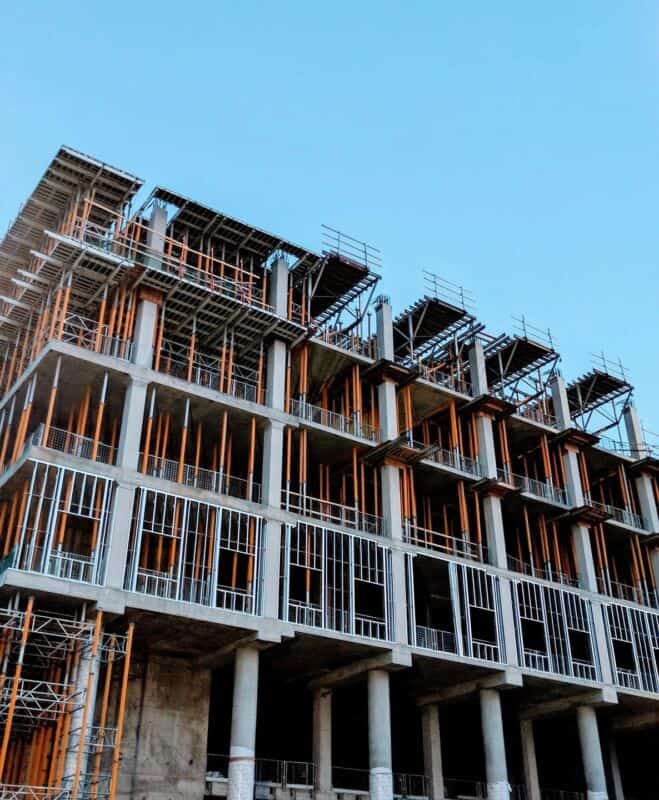
Photo: Construction equipment prepares the site for two new Intel Corp. chip factories in Chandler in this 2021 file photo. Intel’s plan to spend $20 billion on the project, along with TSMC’s later pledge to invest $26 billion for semiconductor manufacturing in Arizona, made up the bulk of the $58 billion in private investment in Arizona that is being touted by federal and state officials. (Photo courtesy Intel Corp.)
Arizona has attracted more than $58 billion in private investments for manufacturing since 2021, one of the highest levels in the country, according to the White House, which calls it proof that the president’s economic agenda is working.
“This is starting to have a real impact for people, for families, for communities,” said Bharat Ramamurti, the deputy director of President Joe Biden’s National Economic Council.
“There’s more work to be done, but because of the policies the president has been putting in place, because of his Invest in America agenda, we’re seeing real results take hold,” Ramamurti said during a phone interview this week.
Arizona analysts and experts agree that federal policies likely played a role in the investments, but they said Biden can’t claim all the credit: They pointed instead to an “ecosystem of individuals” on the state and local levels who worked for years to “put Arizona in the positive spot it is in today.”
Mike Huckins, vice president of public affairs of the Greater Phoenix Chamber of Commerce, said federal support helps but the federal government is “not a savior for Arizona.”
“The efforts of lawmakers and the private sector in Arizona, long before this money came along, has had a major, major impact on businesses locating and expanding here,” Huckins said.
The White House said the Arizona funding is part of more than $435 billion in private investment for projects in every state over the last two years. Ramamurti was not able to rank the states Tuesday, but confirmed that Arizona was one of the top states for investments during that period.
More than $200 billion of the investment is slated for semiconductor manufacturing across the country and another $200 billion has been pledged for clean-energy products such as electric vehicles and batteries, according to administration data. Investment in Arizona followed that pattern, with much of the funding planned for semiconductors and battery manufacturing.
The largest amount in Arizona is the $26 billion pledged by Taiwan Semiconductor Manufacturing Co., which plans to build two TSMC plants in the state. Intel has promised to invest $20 billion to facilities it operates in Chandler, while LG Energy Solution has said it will spend $5.5 billion to make electric vehicle batteries in Queen Creek.
“There’s a multiplier effect,” Ramamurti said. “You have a big factory making an investment, small businesses sprout up.”
But Daniel Scarpinato, who served as chief of staff to former Gov. Doug Ducey, said the groundwork for those gains was laid long before Biden took office.
“Arizona is actually now No. 1 for foreign investment, and that is a result of the focus that was really made over the last eight years on economic development, on our business environment,” Scarpinato said, “and on the governor specifically recruiting some of these companies, including TSMC, LG, the expansion that we saw with Intel, etc., etc.”
He pointed to separate trips to Asia by Ducey and Phoenix Mayor Kate Gallego to build relationships with TSMC and LG Energy that paid off in the recent investments. Scarpinato also said Sandra Watson of the Arizona Commerce Authority and Danny Seiden of the Arizona Chamber of Commerce have been part of the network that helped land those deals.
An Arizona State University economist said that the state’s “culture of welcoming business” has fostered relationships with companies like TSMC and LG Energy in recent years. But Dennis Hoffman said there’s no doubt that Biden-era policies have helped those relationships flourish.
“This chips bill (the CHIPS and Science Act) to some degree, and the clean energy incentives for autos that lead to the need for more battery manufacturing, you can draw the direct link from that type of legislation to these types of businesses,” said Hoffman, director of the L. William Seidman Research Institute at the W.P. Carey School of Business.
Universities are also a major player in helping promote manufacturing growth for the state, Hoffman said, as they provide the research and workforce needed in semiconductor and battery industries.
Whatever the reason, the Biden administration is eager to capitalize on the good news.
Biden traveled to North Carolina on Tuesday to visit a semiconductor plant where a $5 billion private investment is expected to create up to 1,800 new jobs. It was the kickoff of a planned three-week, 20-state Investing in America tour that will see the president and vice president, Cabinet members and the first lady and second gentleman fanning out across the country to visit sites of similar investments.
The administration said policies like the CHIPS Act and funding from the president’s infrastructure bill and Inflation Reduction Act have enabled the investments that will “boost U.S. competitiveness, rebuild infrastructure, strengthen supply chains, and help build a clean energy economy.”
Huckins said there is no denying the investments are good news for the state.
“Workers coming into Arizona to work … are going to need to go to new places to live, so that’s going to benefit the housing industry,” he said. “They’re going to need places to go eat, so that’s going to benefit the grocery stores and the restaurant industry.”
Scarpinato said he worries an “unending amount of money that is coming in” to the state from the federal government is exacerbating the state’s already-high inflation. But Hoffman is not as concerned, saying the fact that there is more money in the system is manageable.
“People want to come here, live and go to school in a vibrant community with the idea that they can earn an education here and join the workforce and have a lucrative career,” Hoffman said.
“It’s serendipity for sure,” he said of the confluence of factors. “It’s federal government action, it’s local government action with respect to incentives in organizing the investment here and coordinating all the activities that have to take place to make this investment successful.”


